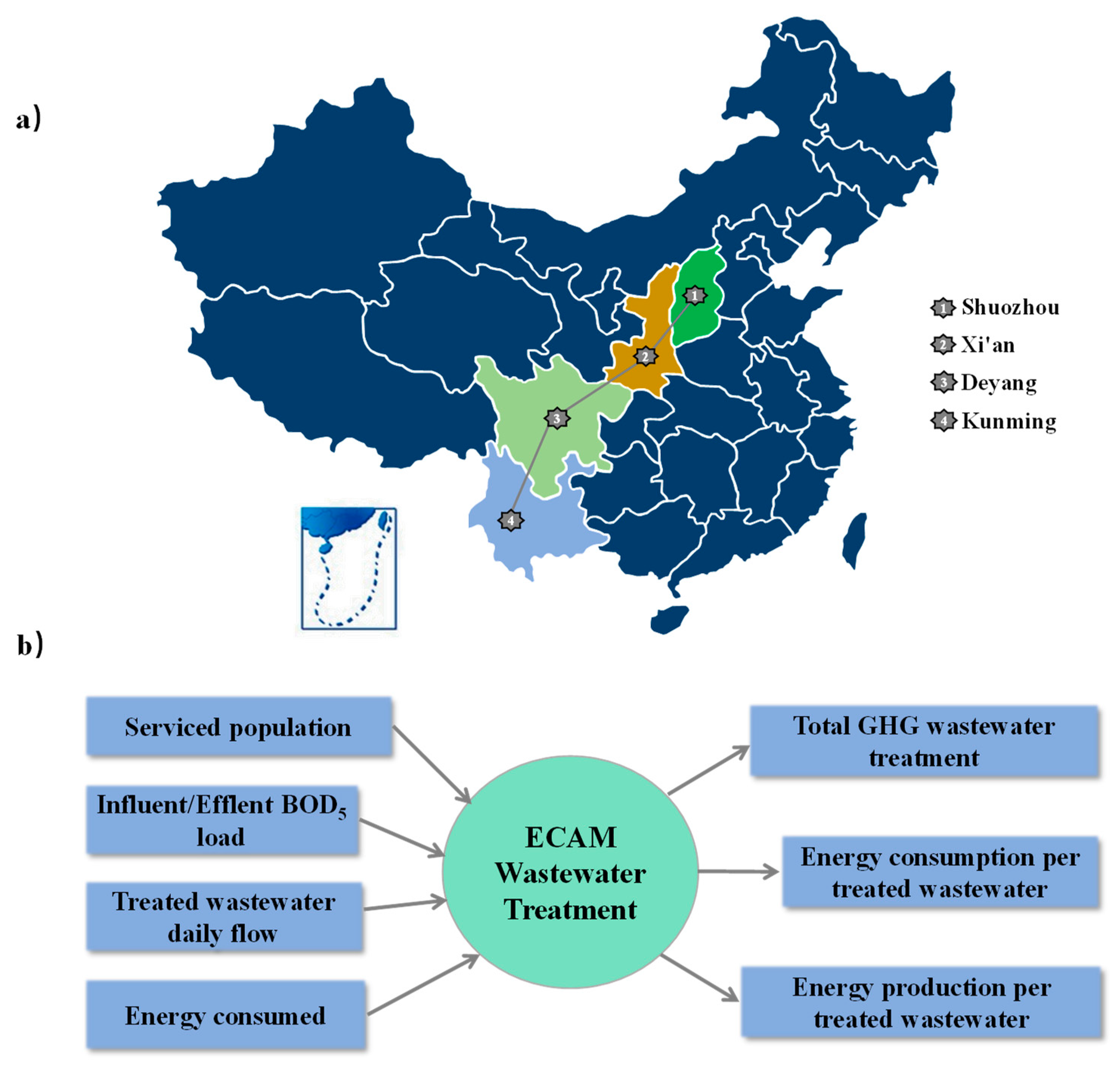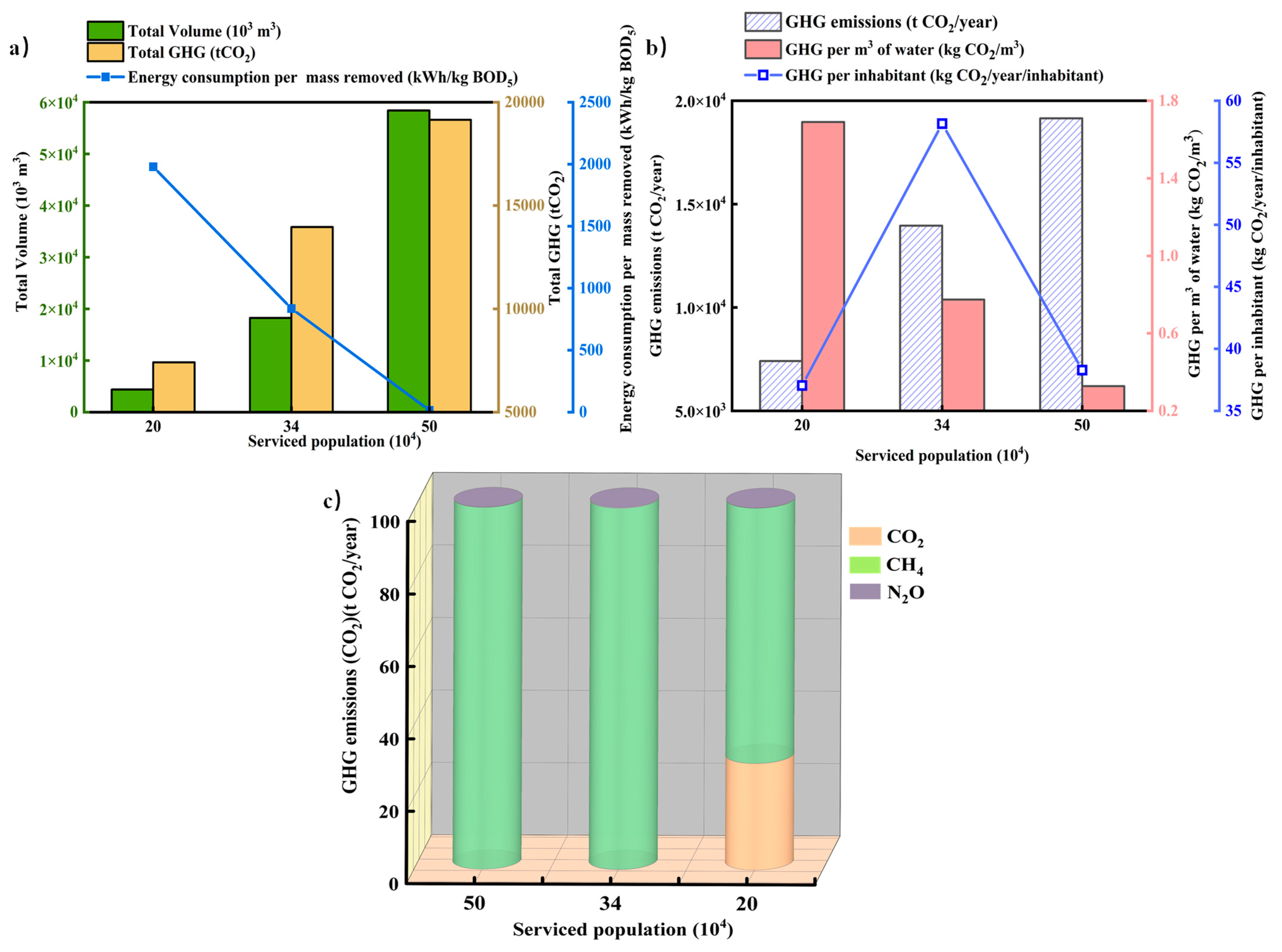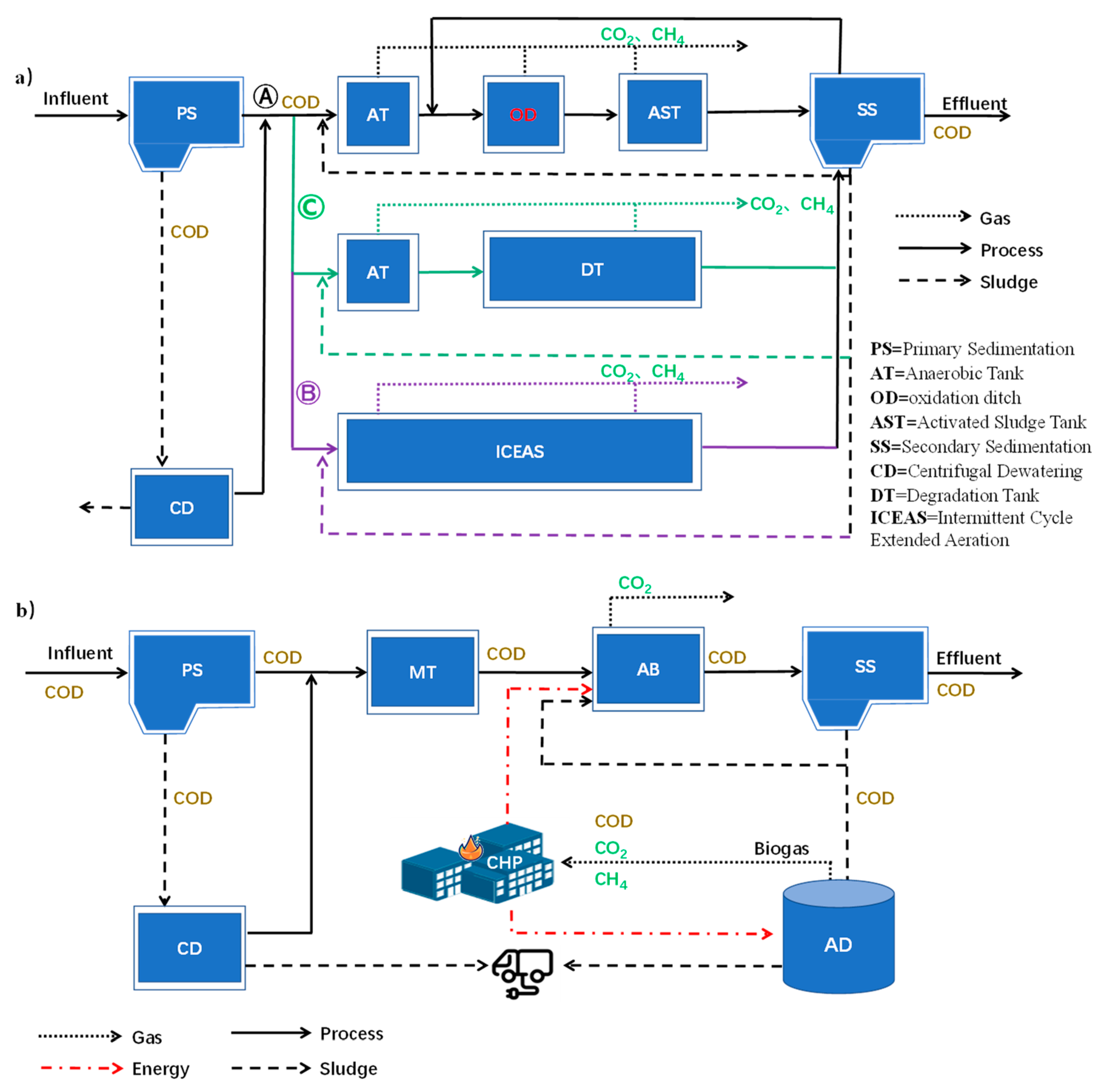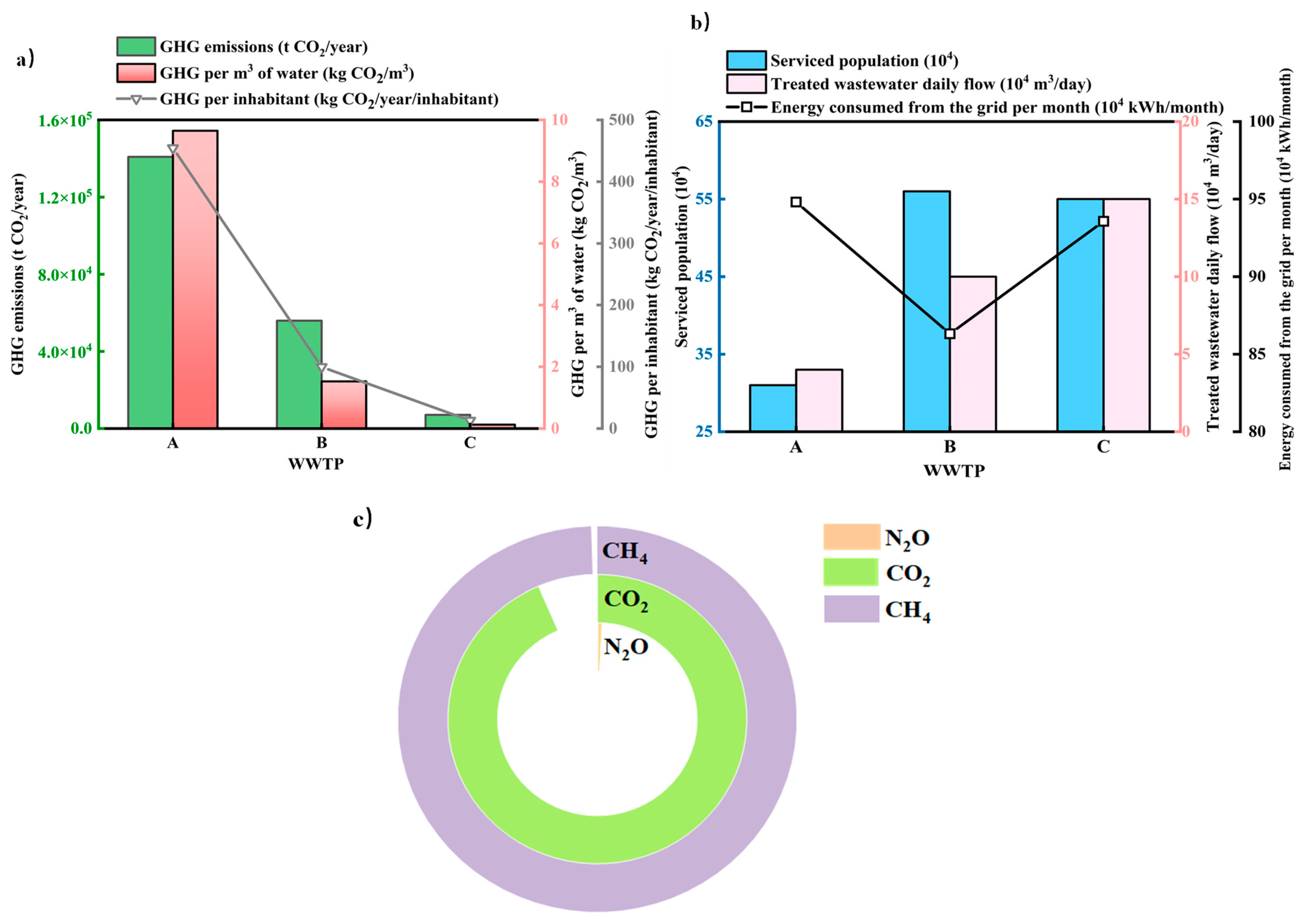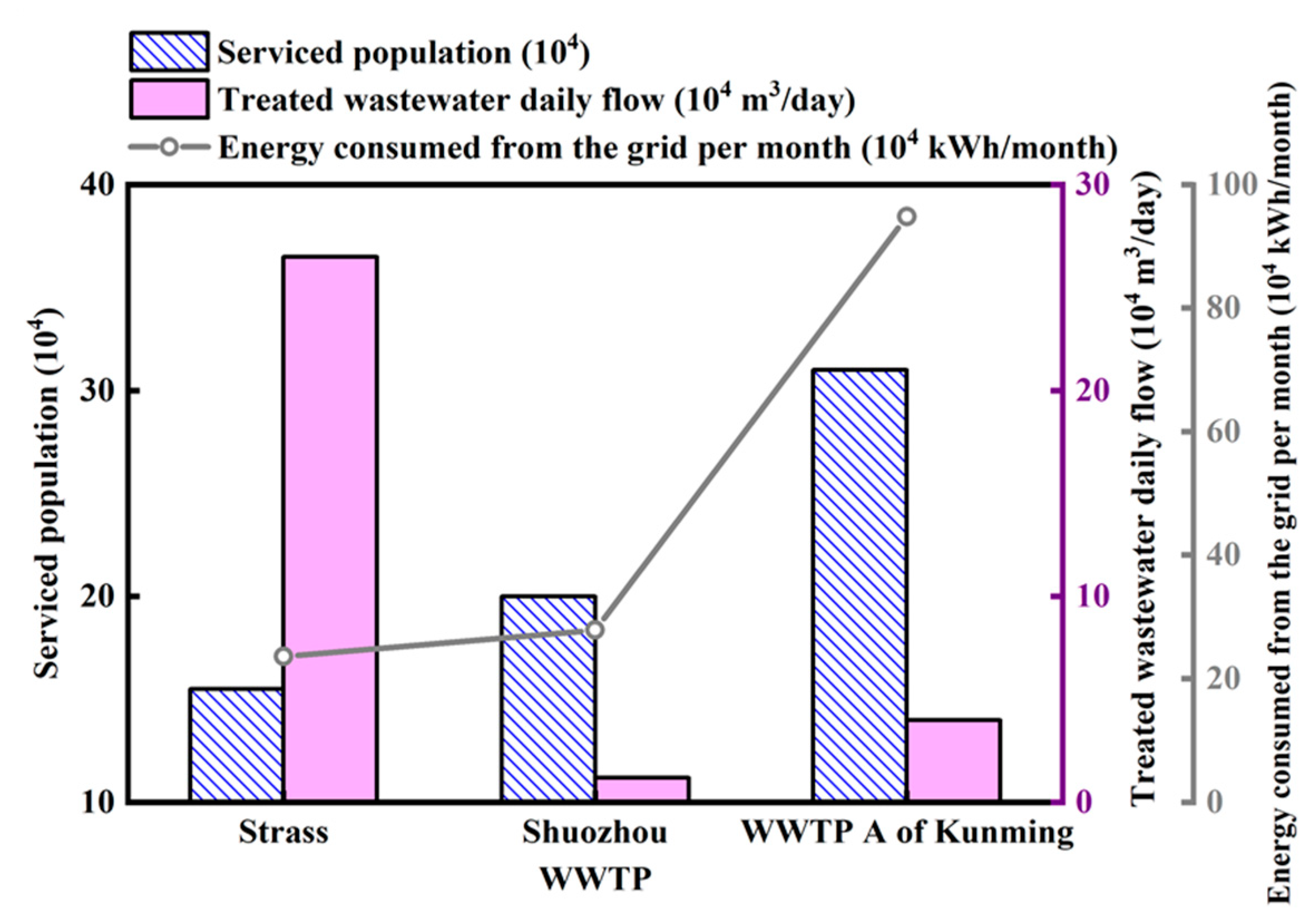1. Introduction
Sewage is the carrier of resources and energy, which contains a large amount of organic matter [
1]. Organic matter is an energetic substance, and sewage also contains a large number of plant nutrients, which contains great chemical energy and thermal energy. However, traditional wastewater treatment usually separates, degrades and converts pollutants in water through various complex artificial technical means, regardless of the consumption of resources and energy, which is a process of “energy consumption” and “pollution transfer” [
2,
3]. At the same time, biosorption is being developed as an alternative treatment method to replace traditional remediation methods [
4,
5]. According to statistics, Chinese carbon emissions ranked the forefront of the world. In 2014, Chinese urban sewage production was 5.546 million m
3, wastewater treatment energy consumption accounted for 0.73% of the total electricity consumption, and greenhouse gas (GHG) emissions reached 91 million tons. Cities are the most important units for carbon and local air pollutants emission accounting, statistics and management [
6]. Studies have shown that wastewater treatment volumes are as high as 200 million cubic meters per day and that carbon emissions from wastewater treatment systems account for 1% to 2% of total carbon emissions, more than 25% of global carbon emissions, with a growing trend [
7,
8,
9,
10]. The municipal wastewater treatment industry is a major energy source in China, occupying a large amount of energy and producing a large number of greenhouse gases. Under the current situation of double improvement of sewage collection and pollutant removal ratio, the energy consumption problem of wastewater treatment plant (WWTP) is becoming more and more prominent and serious [
11].
Under the background of carbon neutralization, the carbon neutralization operation of low-carbon urban domestic sewage plants is undoubtedly the future development direction of the wastewater treatment industry. The total amount of carbon dioxide directly or indirectly emitted by WWTPs in a certain period of time is offset by self-produced clean energy, adopting low-energy treatment process, and implementing energy-saving transformation of equipment, so as to realize the net “zero emission” of GHGs in WWTPs, which has the advantages of low energy consumption, low emission, and sustainability [
12,
13]. The latest research progress of carbon neutralization technology in WWTPs was investigated, and the energy consumption value was analyzed, in order to provide reference for the realization of carbon neutralization operation of urban WWTPs in China.
Some studies show that the influent COD concentration of municipal wastewater is about 250–950 mg/L. Depending on the COD load consumed, different calculations have different results. But in general, its potential energy value is 1.66–1.93 kW·h/m
3 (COD = 430–500 mg/L) or as high as 3.09–3.86 kW·h/m
3 (COD = 800–1000 mg/L) [
14]. The typical energy consumption of activated sludge process (CAS) containing nitrification process is 0.35–0.80 kW·h/m
3, which has broad research prospects for the recovery of residual energy in the realization of low carbon WWTP [
15].
The so-called low-carbon wastewater treatment is the realization of carbon neutralization by wastewater treatment. It refers to the total amount of carbon dioxide directly or indirectly emitted by WWTPs in a certain period of time, which is completely offset by the production of clean energy, the use of low-energy treatment technology, and the implementation of the energy-saving transformation of equipment, so as to realize the net “zero emission” of GHGs in WWTPs. In recent years, the research shows that the practical ways of carbon neutralization in WWTPs mainly include the utilization of sewage temperature heat energy, sludge cogeneration, carbon source capture of raw water, solar photovoltaic power generation, application of low-energy wastewater treatment process, and energy saving transformation of high-energy equipment [
16,
17]. For the vision of future water recycling plants, Suez company analyzed its 30 sewage plants operating in France and summarized five directions: energy efficiency optimization, nutrient recovery, sludge reduction and reuse, bio-gas recycling, and production of new substances [
18].
Exploring the sustainability of WWTPs in terms of energy recyclability and environmental impact is now the novel challenge. By evaluating the service population and treatment efficiency of different WWTPs, it is possible to compare their performance and determine the optimal operation, thereby reducing carbon emissions and achieving carbon neutrality.
The purpose of this study is to: (1) Explore the impact of city size on carbon emissions and energy consumption; (2) evaluate the energy consumption and GHG emission of different biological treatment processes based on modified A2/O oxidation ditch process; (3) compare the domestic plants in China with foreign treatment plants that combine anaerobic digestion.
3. Results and Discussions
In this study, three schemes were compared to evaluate the energy estimation and carbon emissions of wastewater treatment process in different cities and processes, to explore their law of energy estimation and carbon emissions. The comparison results of the three schemes were listed in
Table 1.
3.1. Scheme 1: Impact of City Scale on Carbon Emissions and Energy Consumption—Energy Estimation and GHG Emission in Different Cities
The service population of WWTPs was positively correlated with the urban population, which helped to analyze the differences in energy consumption and GHG emissions when the same process was applied to different cities. Scheme 1 focused on the traditional process and widely used A2/O process. In order to make the analysis representative, the domestic cities were divided into three levels according to the population. The population of the first-level city was more than 500,000 people, taking an example of Xi’an WWTP serving population of 500,000. The second-level city was 300,000–500,000 people, taking the example of Deyang WWTP serving population of 340,000. The third-level city was 100,000–300,000 people, taking an example of Shuozhou WWTP serving population of 200,000. The WWTP of these cities owns the traditional A2/O process.
3.1.1. Data Input of ECAM
The detailed data of water inflow, water quality, and energy consumption of the three municipal WWTPs are shown in
Table 2. Through the input of the original data, the power consumption of WWTPs in Xi’an, Deyang, and Shuozhou was 4.94 × 10
5 kW·h, 5.02 × 10
6 kW·h, and 3.35 × 10
6 kW·h, respectively. Under the same process conditions, the influent quality of each WWTP was different. The influent BOD
5 of Xi’an WWTP with the largest service population can reach 35,200 kg per year, while the influent BOD
5 of Shuozhou WWTP with the smallest service population was 1800 kg per year. It can be seen that the energy consumption of wastewater treatment was positively correlated with the influent organic load. When sufficient organic matter was provided, the water treatment reaction can be fully carried out without providing additional energy. Thus, if the WWTP was to achieve the goal of energy conservation and emission reduction, it was necessary to ensure sufficient organic supply in the influent to reduce energy consumption.
3.1.2. Outputs of the Calculated GHG by ECAM
The ECAM tool evaluated the carbon emissions based on the detailed information of each WWTP.
Figure 2a shows that the amount of wastewater treatment increased with the growth of the population. Xi’an the first-level city with the largest permanent population had the largest annual treatment capacity, reaching 58.4 million m
3. In addition, the second-level city of Deyang and the third-level city of Shuozhou had annual treatment capacities of 18.02 and 4.38 million m
3, respectively.
The relationship between population and per capita GHG in the municipal wastewater treatment process was demonstrated in
Figure 2b. According to the analysis of carbon dioxide (CO
2) emission per person per year in the evaluation data, the annual GHG emission per capita in the service area of a WWTP in Deyang was the highest in three cities and the annual GHG emission per person was estimated to be 58.16 kg CO
2. However, Xi’an WWTP and Shuozhou WWTP the annual GHG emissions per person were estimated to be 38.29 kg CO
2 and 37.05 kg CO
2, respectively. The comparison displayed the annual inflow BOD
5 of 6500 kg in Deyang WWTP, which was higher than that of Shuozhou with BOD
5 of 1800 kg when the treatment process and service population were similar. It can be concluded that the emission of greenhouse gases was related to the influent quality. The higher the organic load in the influent quality, the higher the carbon emissions were likely to be.
In the process of wastewater treatment, the GHGs which lead to the increase in carbon emissions were mainly composed of methane (CH
4), CO
2, and nitrous oxide (N
2O). From the GHG composition analysis of three urban WWTPs in
Figure 2c, CH
4 was the dominant one, and the annual CH
4 emission of a WWTP in Xi’an can reach 19,215 t CO
2eq. The N
2O emissions from WWTPs in three levels of cities were the least GHGs can reach 777 t CO
2eq. Shuozhou WWTP had the least service population and the smallest influent BOD
5 load. The proportion of CH
4 emission was relatively small, while the proportion of CO
2 emission increased, the value of GHG emissions was 325 t CO
2/year. As a new energy, CH
4 had great recycling value, which had a potential role in promoting the realization of energy conservation and emission reduction targets. It can be seen that a large number of CH
4 emitted can be fully recovered. How to realize the recovery of CH
4 and control various types of greenhouse gases was closely related to the water treatment process used.
The amount of GHGs emitted by the three WWTPs in each stage of the wastewater treatment process has been evaluated in
Table 3. Wastewater treatment process, sludge treatment process, sewage discharge process, and power consumption process will emit a certain amount of GHGs. The evaluation results show that the amount of greenhouse gases emitted by the wastewater treatment process was the largest. This was because the selected A
2/O process in the reaction process was anaerobic, anoxic, aerobic alternative operation.
3.2. Scheme 2: Feasibility Evaluation of Different Biological Treatment Processes—Energy Consumption Estimation and GHG Emission of Modified A2/O Oxidation Ditch Process
Although the A2/O oxidation ditch process can achieve high standard effluent, it will consume a lot of energy. Therefore, in order to take full advantage of this process, it was necessary to estimate and analyze the emissions. Full consideration needed to be given to the recovery and use of energy and to assessing the value of recovered energy. Under the condition of controlling the relevant factors analyzed in this study, it was necessary to improve the existing process to further save energy and reduce carbon emissions. Hence on the basis of traditional A2/O process, Scheme 2 of this study analyzed the energy estimation and GHG emission of the improved A2/O oxidation ditch process.
3.2.1. Improving the Selection of A2/O Processes
So as to judge whether the improved process had outstanding advantages, WWTP with different processes in a certain area of Kunming was selected. The independent variable of controlling the quality of inlet and outlet water was the same, and different processes were changed. At the same time, the GHG emission coefficient also changed. The energy estimation difference and GHG emission of improved A2/O oxidation ditch, anaerobic, and aerobic processes were analyzed. ECAM online assessment tool was used to evaluate the composition of GHG emissions and to analyze the proportion of recyclable gases, which afforded a method to determine whether a process had the value of recycling energy. If it was confirmed that the new energy gases such as biogas produced by this process had reached a certain level and had the value of energy recovery, the biogas produced by anaerobic digestion, gas collection and cogeneration can be recovered. In the era of advocating carbon neutralization, it was undoubtedly the preferred way to get twice the result.
As shown in
Figure 3a, the direct carbon emission process in the A
2/O process was a biodegradation process. Studies had shown that CH
4 usually had the highest yield in the anaerobic stage, which was because the anaerobic tank provided a strict anaerobic growth environment for methanogenic bacteria, and the degradation of organic matter releases CH
4 and CO
2 into the environment [
27]. Under anoxic conditions, ammonia nitrogen in water was oxidized to nitrite and nitrate, and CO
2 was released. N
2O was produced by nitrification in the anaerobic tank and anoxic tank dissolved in water and released under aeration agitation in the aerobic zone. N
2O production increased when the oxygen supply was insufficient [
28]. N
2O production of three WWTPs was the least in GHG, which showed that the aeration is sufficient. Most countries consider anaerobic as a less costly and efficient way to recycle CH
4 [
29]. A WWTP in Kunming gave this idea, the oxidation ditch process into A
2/O adopted the improved A
2/O oxidation ditch process.
For the purpose of analyzing the outstanding characteristics of the improved A
2/O oxidation ditch process, due to the same service area, it was assumed that the inlet and outlet water quality of each WWTP was the same, the process flow was changed, and the energy consumption and GHG emission of various processes were compared. The improved A
2/O oxidation ditch process was used in WWTP A as shown in
Figure 3a(Ⓐ). WWTP B adopted an anaerobic process as shown in
Figure 3a(Ⓑ) and WWTP C used an activated sludge intermittent cycle extended aeration (ICEAS) process as shown in
Figure 3a(Ⓒ). The improved A
2/O oxidation ditch process provided longer hydraulic retention time, improved ammonia nitrogen oxidation efficiency and higher reductase activity of ammonia-oxidizing bacteria and nitrite-oxidizing bacteria in activated sludge [
30]. Ammunition, nitrification, and denitrification reactions were more thorough, which can fully convert carbon in organic matter into CH
4 for further recycling.
3.2.2. Data Input of ECAM
Table 4 were the basic data of three WWTPs that input ECAM. Among the three WWTPs, WWTP A had the least serviced population, only 310,000 people. In addition, WWTP B and WWTP C had similar service populations, 550,000 and 560,000 respectively. There was a roughly positive correlation between the wastewater treatment capacity of the three plants and the service population. From
Figure 4a, it can be clearly seen that the sewage volume will also increase with the increase in the service population.
By analyzing the energy consumption WWTP A, B, and C of Kunming, it was found that the energy consumption of plant B was significantly lower than that of plants A and C. The average monthly energy consumption of plant B was 8.63 × 10
5 kW·h, while the average monthly energy consumption of plant A and C was 948,101.583 kW·h and 9.36 × 10
5 kW·h, respectively. This was due to the fact that plants A and C require a large amount of aeration to maintain the aerobic environment, while plant B only adopted anaerobic process without continuous aeration, which reduced energy consumption. However, the lack of aerobic environment was easy to lead to incomplete nitrification and incomplete decomposition of organic matter. As a consequence, the anaerobic process alone was suitable for small WWTPs with low effluent quality requirements. WWTP A served significantly more people than WWTP B and WWTP C; however, energy consumed from the grid per month was the highest as seen in
Table 4.
3.2.3. Outputs of the Calculated GHG by ECAM and Energy Recycling Analysis
The analysis in
Section 3.2.1 shows that GHG emissions were positively correlated with population in different levels of cities, but GHG emissions were obviously not correlated with the population for different WWTPs in the same city. The service population of Kunming Plant A was the smallest, but it can be seen from
Figure 4a that the carbon emission of Plant A was the highest. Specific values were collated in
Table 5. The GHG emission was 1.41 × 10
8 kg CO
2eq per year on average. The carbon emission of the water treatment process accounted for the majority, which was 1.52 × 10
8 kg CO
2eq. The GHG emission of energy consumption process accounted for the second, which was 1.13 × 10
7 kg CO
2eq. It was visible that in the same area, GHG emissions are closely correlated with the selected wastewater treatment process. Among them, the GHG emissions of aerobic process were the least, followed by the anaerobic process, and the GHG emissions of aerobic combined with anaerobic and anoxic mixed process were the most.
For WWTP A of Kunming with the largest GHG emission, the GHG composition was mainly composed of CH
4, CO
2, and N
2O, which is shown in
Figure 4c. The largest gas emission was CH
4. In various processes of wastewater treatment, the CH
4 emission from Kunming WWTP of A was 1.52 × 10
8 kg CO
2. CO
2 emissions followed by 1.13 × 10
7 kg CO
2 and the least emission was N
2O, only 6322 kg CO
2. As a new energy gas, CH
4 had the value of recycling. At present, the WWTPs generally begin to adopt the combined process of anaerobic digestion and cogeneration and use CH
4 to generate heat energy or convert it into kinetic energy, which is provided to other process parts of the WWTP.
Qingdao WWTP used the process to convert the energy generated by biogas into heat sources and gas sources for sludge tanks and pumps. After the renovation of the WWTP in 2018, the water treatment process collected 6.11 × 10
6 Nm
3·a
−1 CH
4 [
31], which is equivalent to 4.38 × 10
6 t CH
4. According to the IPCC Guidelines for National Greenhouse Gas Inventories, 1 t CH
4 = 21 t CO
2eq was used to calculate the CO
2 equivalent of GHGs. The collected CH
4 was equivalent to 2.08 × 10
8 t CO
2, and the power generation was 1.02 × 10
8, providing more than 60% of the power consumption of the whole plant. The Kakolanmäki WWTP in Finland used the heat exchange of effluent and the energy generated by methane as the main energy sources of the WWTP. The annual energy consumption of the WWTP was 12,755 MW·h, and the energy recovered from biogas can reach 21,935 MW·h, achieving 100% recovery and utilization of energy [
32].
3.3. Scheme 3: A Comparison of Domestic and International Low-Carbon Wastewater Treatment Processes—Energy Analysis and Carbon Emission Assessment of Low-Carbon Wastewater Treatment Processes Considering Energy Recovery
As there were few cases of recycling biogas and generating energy in China, scheme 3 selected the Strass WWTP in Austria, the pioneer of carbon neutralization, as the representative of biogas recycling. The plant was a WWTP where the dominant method was the “AB” method and the side flow process was low carbon, low consumption anaerobic ammonia oxidation process. It was an early pioneer in the water treatment industry in terms of carbon neutrality. The main process flow and energy flow were shown in
Figure 3b. By comparing with the Shuozhou WWTP with the best energy utilization ratio in scheme 1 and the Kunming A wastewater treatment station with the improved process in scheme 2, the energy estimation direction was analyzed. The energy estimation value and GHG emission value evaluated by ECAM tool were used to evaluate the contribution value of recycling new energy gas to energy conservation and emission reduction and low carbon wastewater treatment process construction.
3.3.1. Data Input of ECAM
For the sake of verifying the contribution of the new process in achieving low carbon and low energy consumption, this study used ECAM tool to evaluate the energy consumption and carbon emissions of Strass WWTP, Shuozhou WWTP, and WWTP A of Kunming. The initial data of the three WWTPs input ECAM tools were shown in
Table 6. The permanent population of Strass WWTP fluctuated greatly, about 60,000 in summer and 250,000 in winter, serving a population of about 155,000. The previous analysis showed that the energy consumption of wastewater treatment was positively correlated with the service population and treatment capacity when the wastewater treatment process was the same. When the wastewater treatment process and the location of the WWTP were different, as shown in
Figure 5, the population of the three WWTPs increased in turn. Although the service population of the Strass WWTP was the least, the treatment capacity was the largest, up to 26,500 m
3/day. The treatment capacity of Shuozhou WWTP and A WWTP was only 12,000 m
3/day and 40,000 m
3/day, respectively.
3.3.2. Outputs of the Calculated GHG by ECAM
Table 7 shows the assessment of GHG emissions at each stage of the wastewater treatment process of the three wastewater treatment plants. The output results showed that Shuozhou WWTP and A WWTP produced the most GHG during wastewater treatment, which was consistent with the conclusion in
Section 3.1. However, Strass WWTP consumes the most electricity, reaching 8.59 × 10
7 kg CO
2eq/year. This is because the energy consumption of Strass WWTP was the least among the three WWTPs, which consumed only 236,070 kW·h per month. The core of achieving the goal of “energy saving” was that it used anaerobic digestion-thermoelectric cogeneration technology to recover CH
4 produced in the water treatment process and convert it into energy reuse. In 2005, the total energy consumption of each unit in Strass WWTP was 2.87 × 10
6 kW·h, the calorific value of CH
4 was 35.9 MJ/m
3, and the conversion efficiency of electric energy was 2.3 kW·h/m
3. The capacity/energy consumption can reach 40% after replacing the cogeneration unit, and about 14% of the aeration can be saved [
33,
34].
4. Conclusions
In summary, the ECAM tool used in this study can be used in other cities in China, and even cities around the world. First, it was found that wastewater treatment energy consumption was positively correlated with the influent organic load. The ratio of treated wastewater daily flow to influent BOD was more than 4.5. Next, by comparing the conventional process with the novel low carbon process, the mixed process combining aerobic with anaerobic and anoxic emitted the most GHG, and the GHG emissions of aerobic process was the least. Finally, the energy production per treated wastewater of Stass WWTP was 0.32 kW·h/m3. The energy consumption of Xi’an WWTP and Deyang WWTP was 0.0085 kW·h/m3 and 0.28 kW·h/m3, respectively. If the energy recovery process was applied to the process improvement of the above two WWTPs, both can achieve 100% energy recovery with a view to achieving energy self-sufficiency. The collection of GHGs and the recycling of energy provide novel ideas and reference directions for the transformation of wastewater treatment plants to low carbon.
The limitation of this paper is that the accuracy and applicability of carbon emission assessment also depend on the accuracy of the methods used and the input data, because the carbon emission of sewage treatment plants depends largely on the operation of wastewater treatment processes. If the measured data are inaccurate, resulting in errors in the input data, the use of ECAM online assessment tools may lead to incorrect carbon emission assessment, thus deviating from reality.
